A rare iconographic subject from the age of the Counter-Reformation links two beautiful northern Italian cities, Mantua and Riva del Garda: that of the ship of the Church Triumphant. In the Lombard city, the church of San Francesco preserves a fresco that was heavily damaged after World War II bombings in 1944, but is still legible: it is a Triumphus Ecclesiae dating back to the 1570s, and is the work of two artists, Giulio Rubone (1530 - Mantua, 1590), a painter long active in the lands of Mantua in the second half of the 16th century, and the little-known Alessandro da Casalmaggiore (? - 1577), another artist active in the Gonzaga courts, who often collaborated with Rubone. The signature of the two artists was read in 1911, before the fresco was irreparably ruined, by the architect Achille Patricolo, who also gave information about the date (it could be read next to the names of the two artists, although the last digit of the year already at that time could not be discerned). We find the same subject in theAllegory of the Church Triumphant kept at MAG - Museo dell’Alto Garda in Riva del Garda, but coming from the parish church of the Trentino town: for stylistic reasons it has been attributed to the painter Elia Naurizio (Trento, 1589 - 1657), and it is a decidedly later work than its Mantuan counterpart.
Depictions of the Church as a triumphant ship are rather curious and not so common: another one is known to have been engraved in 1602 by Philippe Thomassin (Troyes, 1562 - Rome, 1622), preserved in the Biblioteca Casanatense in Rome and useful for interpreting all the individual elements since it has rich captions, as well as a cartouche that allows us to understand whence the idea of depicting the Church as a ship came from. “Sways often the Ship of Peter,” reads the long cartouche of Thomassin’s engraving, “but does not submerge, is beaten but not broken, oppressed by villains but not conquered.” The image to which Thomassin refers is that of the navicula Simonis Petri attested in Christian tradition beginning with St. Ambrose, the first to liken the Church to a ship to be steered under the watchful eye of God so that it will weather storms and arrive at a portus salutis.
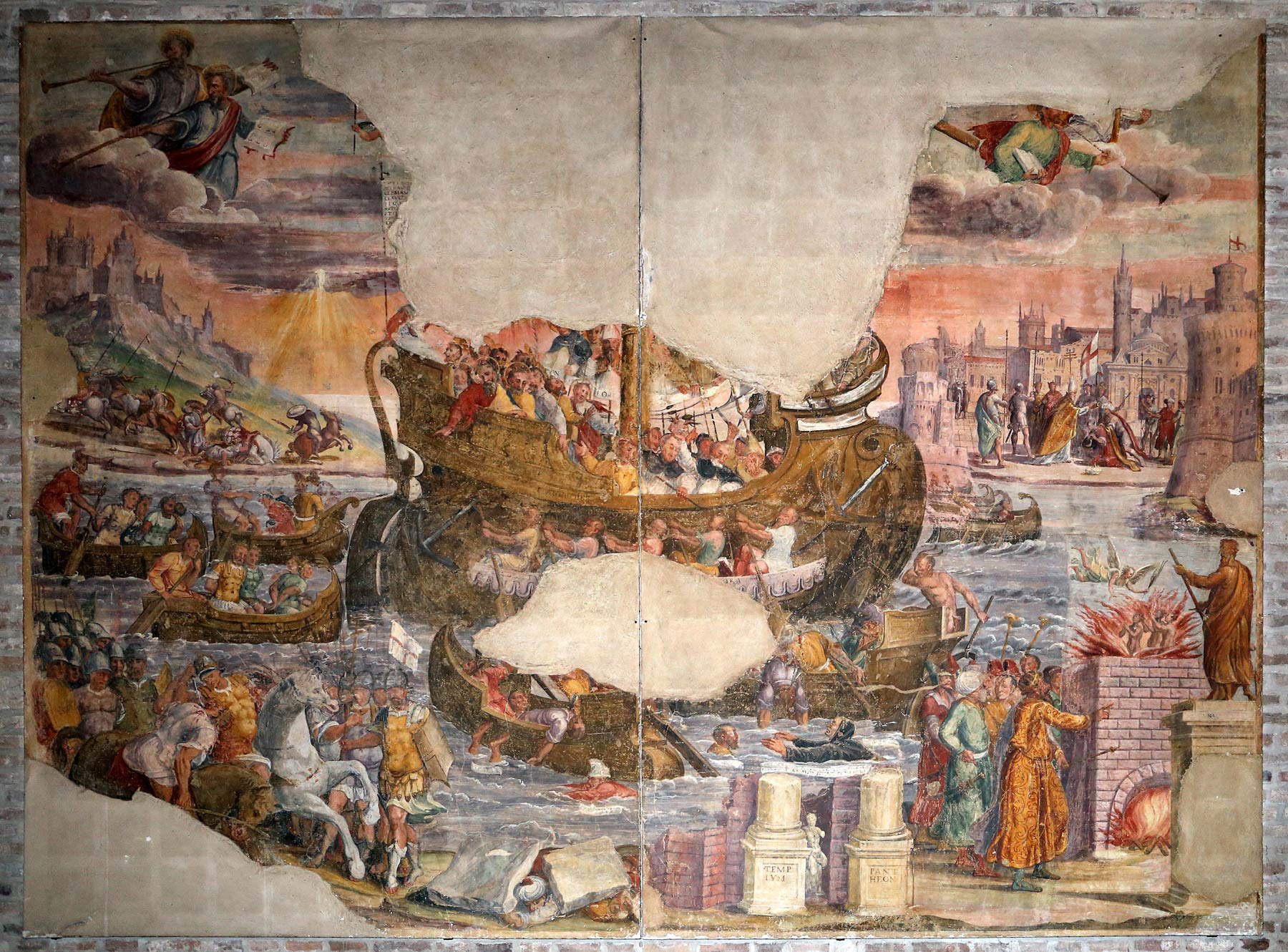

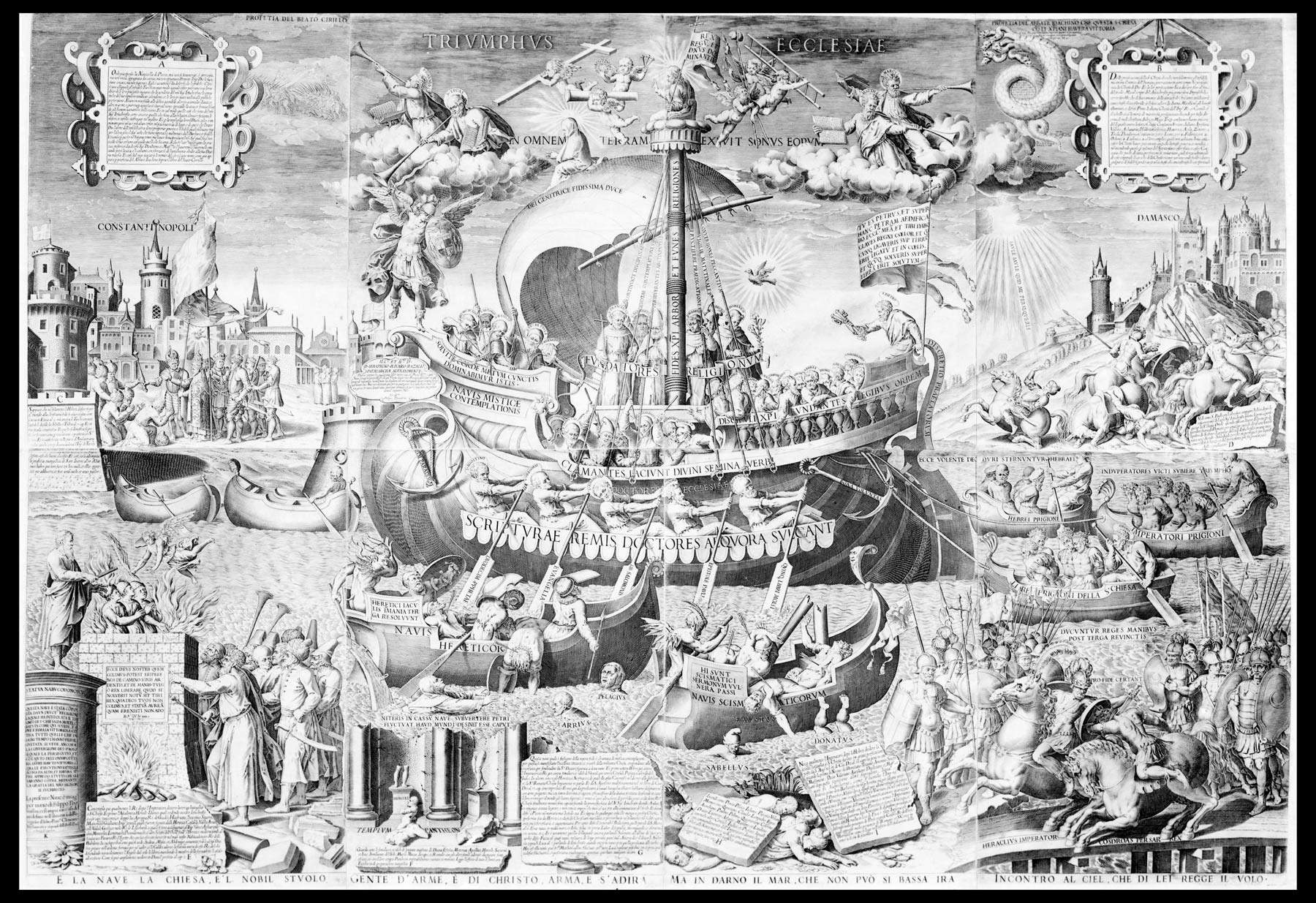
This is a motif that also found some translations in images throughout history. The navicula Petri being rescued by Christ, who is usually depicted bringing Simon Peter to shore kneeling before him, abounds in medieval art, especially in miniatures, but there are also examples executed with other expressive techniques: one thinks of the famous mosaic of the navicella in St. Peter’s, executed to a design by Giotto (some fragments of which remain today), or on the navicula Petri that appears in the predella of Andrea Orcagna’s Strozzi Polyptych, a 1357 work preserved in Florence’s Santa Maria Novella, or the 1366-1368 fresco that Andrea di Bonaiuto painted in one of the four sails of the chapter house of the Santa Maria Novella convent.
However, the image proposed by Rubone, Thomassin and Naurizio is completely different from that of the more traditional navicula Petri: the iconography of which we find the first attestation in San Francesco in Mantua is a complex allegory of the Church’s triumph over its enemies, devised at a time when similar content also held important political significance, when Rome was engaged, on the one hand, in the fight against heresies (and in these three works we find a good number of them: Naurizio’s and Thomassin’s versions, where cartouches can still be read, help to identify them), and on the other hand in the clash with the infidels: it will thus be necessary to recall in this regard that the Battle of Lepanto, fought precisely on October 7, 1571, between the forces of the Holy League (Spain, Venice, the Papal States, Genoa, Savoy, Urbino, the Grand Duchy of Tuscany and the Knights of Malta) and the Ottoman Empire, and resulting in a crushing victory for the Christians, held a profound religious significance, despite the fact that Pope Pius V himself was aware that, politically and militarily, the Cyprus War, the event of which the battle was a part, would be long and difficult (and he was not mistaken, since the Turks soon reconstituted their fleet after that first, heavy defeat suffered at Christian hands, and in 1573 won the war, cleverly exploiting even the divisions in the Christian front). In the immediate aftermath, however, the victory of Lepanto, wrote historian of religions Agostino Borromeo, “was experienced by public opinion not only as a brilliant fact of arms but also as a religious event. The success of the Christian fleet was attributed to the prayers of the pope, considered by contemporaries already a saint, and to the intercession of the Blessed Virgin whom he invoked. Nor was there a lack of those who, in a prophetic and eschatological vision of the battle, glimpsed a miraculous divine intervention destined to generate the conversion of the Turks and, at the same time, to serve as an impulse to stimulate the reform of corrupt Christendom.”
The idea of reviving the iconography of the navicula Petri by linking it to strictly topical events (the war against the Ottoman Empire, the fight against heresies, the reaction to the Protestant Reformation: the Council of Trent had closed in 1563), although without direct references, thus found fertile ground in this historical context, and it is perhaps to be believed that the echo of the battle of Lepanto contributed to the spread of the image of the Church ship. Indeed, according to art historian Víctor Minguez, the iconography of the “ship of the Church” is said to have stemmed precisely from the Church’s “obsession with regaining the city of Constantinople for Christendom.” And the connection with Lepanto is perhaps something more than a hypothesis, since a poem by Spanish historian and poet Bartolomé Leonardo de Argensola entitled Canción a la nave de la Iglesia con motivo de la victoria de Lepanto was given to print in 1634 (but manuscript circulation is attested even before this date). That is not all, however: the iconographic origin of the Triumphus Ecclesiae theme cannot but be linked to some prints from the Protestant area that began to appear in the mid-sixteenth century. An example is the satirical woodcut with the Shipwreck of the Catholic Church, a 1545 work by the German Matthias Gerung (Nördlingen, c. 1500 - Lauingen 1570), and especially the Nave of the Apostles by Matthias Zündt (Nuremberg, 1498 - 1586), which constitutes the most immediate antecedent for the images of Rubone, Naurizio and Thomassin, and which revisits the iconography of the navicula Petri in a Reformed key. We find, for example, Christ alone in the center of the ship (signifying the Solus Christus doctrine that only Jesus Christ is the sole mediator between God and human beings), the three priests administering baptism, communion, and absolution (i.e., the only three sacraments allowed by the Reformation) at the side of the mast, and then the presence, among the rowers, of Martin Luther and Philip Melanchthon, placed alongside such doctors of the Church as St. Basil and St. Augustine. These images would derive from a common precedent, which is not known to us, and of which, however, we can find an echo in a drawing by an unknown German artist, datable to the second half of the sixteenth century and preserved at the Graphische Sammlung in Munich, which depicts the Typus Religionis, an allegory of religion crossing a sea full of pitfalls to reach safe harbor.
It should then be considered that the works of Rubone, Naurizio and Thomassin were born several decades apart (and of Naurizio’s version we do not even know for sure when it was executed). Giulio Rubone’s fresco, for example, took shape in a heavy climate, and it was the artist himself who was the victim: between 1567 and 1568 theInquisition in Mantua carried out a series of arrests among artists and men of letters who frequented the same intellectual circles, and ended up in jail, among others, the ducal architect Giovanni Battista Bertani, the painter and engraver Giovanni Battista Scultori, as well as Giulio Rubone himself and his colleagues Alessandro da Casalmaggiore, Felice Fasani, Croteo Conti, and the architects Cesare and Pompeo Pedemonti. At the time, the aforementioned Pope Pius V, born Michele Ghislieri, a Dominican and inquisitor, had launched a vast action to repress heresies throughout Italy (it was under his pontificate that the tragedy of Pietro Carnesecchi, a Florentine humanist, who was accused of heresy, in particular of being close to the ideas of the reformer Juan de Valdés, and sentenced to death by the Inquisition, was consummated). The election to the Mantuan bishopric in 1567 of Roman Dominican Gregorio Boldrini, which interrupted a long succession of bishops in the Gonzaga family, had made the work of the inquisitors more agile, who that very year had dozens of Mantuan citizens arrested on suspicion of heresy, including the artists mentioned above (the case of Bertani, who had succeeded Giulio Romano as prefect of the ducal factories, was the most sensational). Some got away with public abjuration, while others, firm in their positions (among them the doctor of the monastery of Polirone, Pietro Giudici), were condemned to capital punishment, all in a strongly hostile climate (two Dominicans were killed, and an anonymous call to take up arms against the bishop was also circulated). It has also been speculated that Giulio Rubone’s fresco originated as the auto da fè of some wealthy Mantuan, but there is no confirmation of this. On the other hand, the historical moment in which Thomassin’s and Naurizio’s images took shape was different: at the time, the main problem, rather than fighting heresies, was to spread the Catholic faith throughout the world (the establishment of the congregation “super negotiis Fidei et Religionis Catholicae” dates back to 1599, while the foundation of the congregation “de propaganda fide” dates back to 1622).
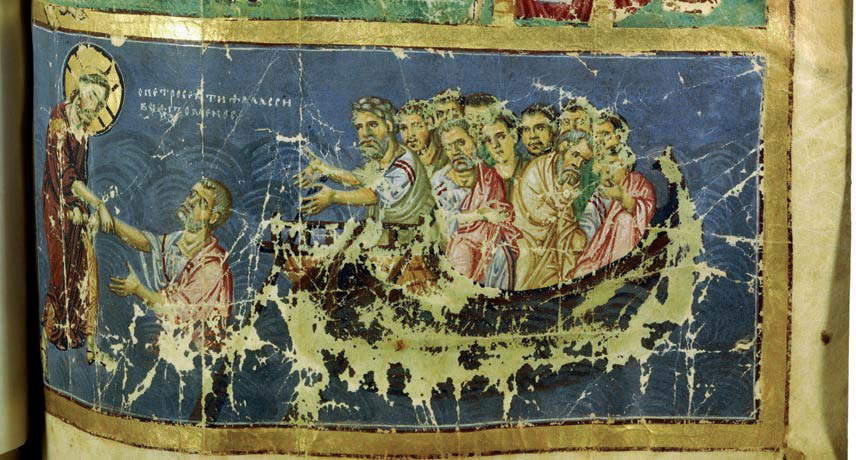



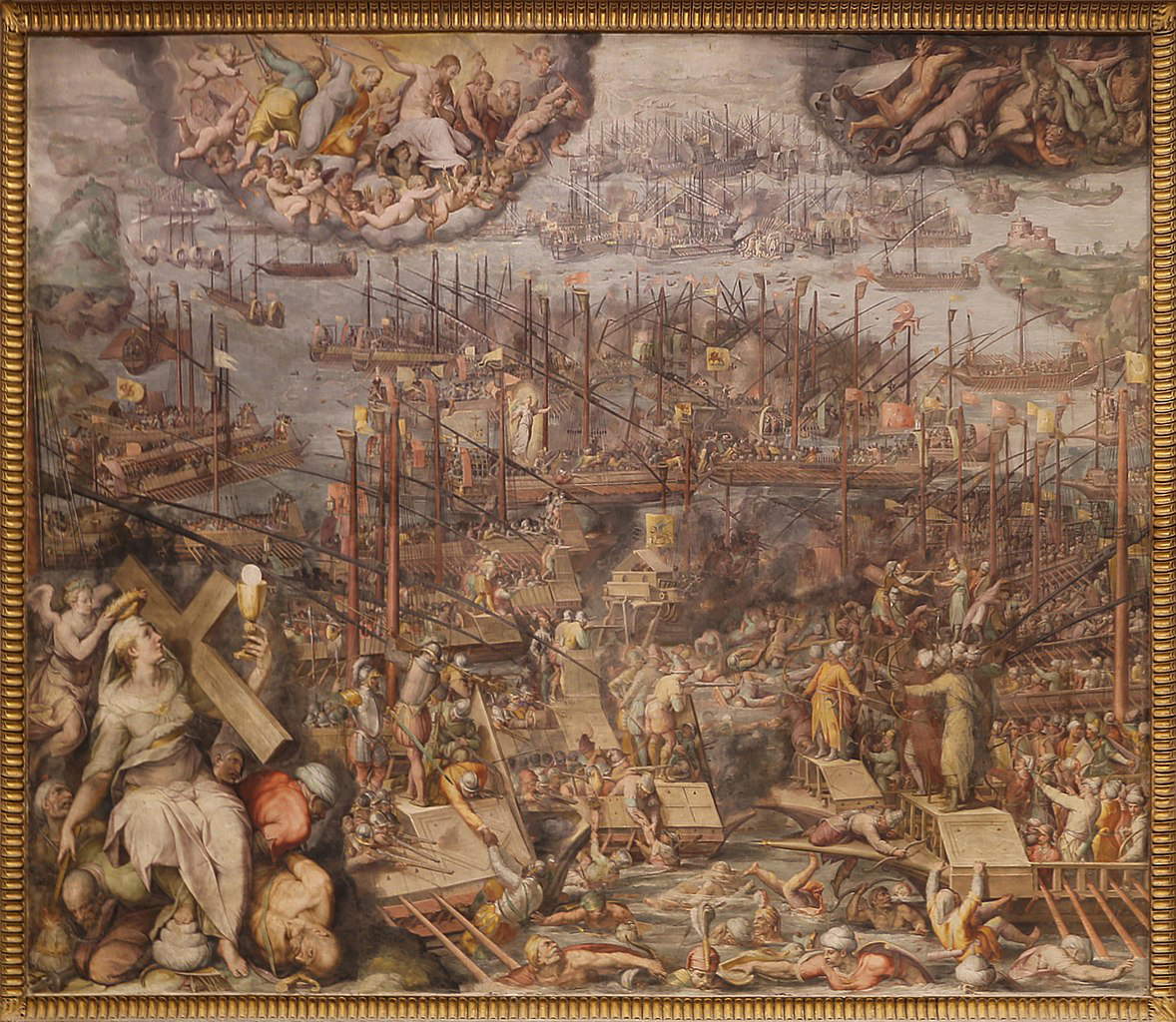

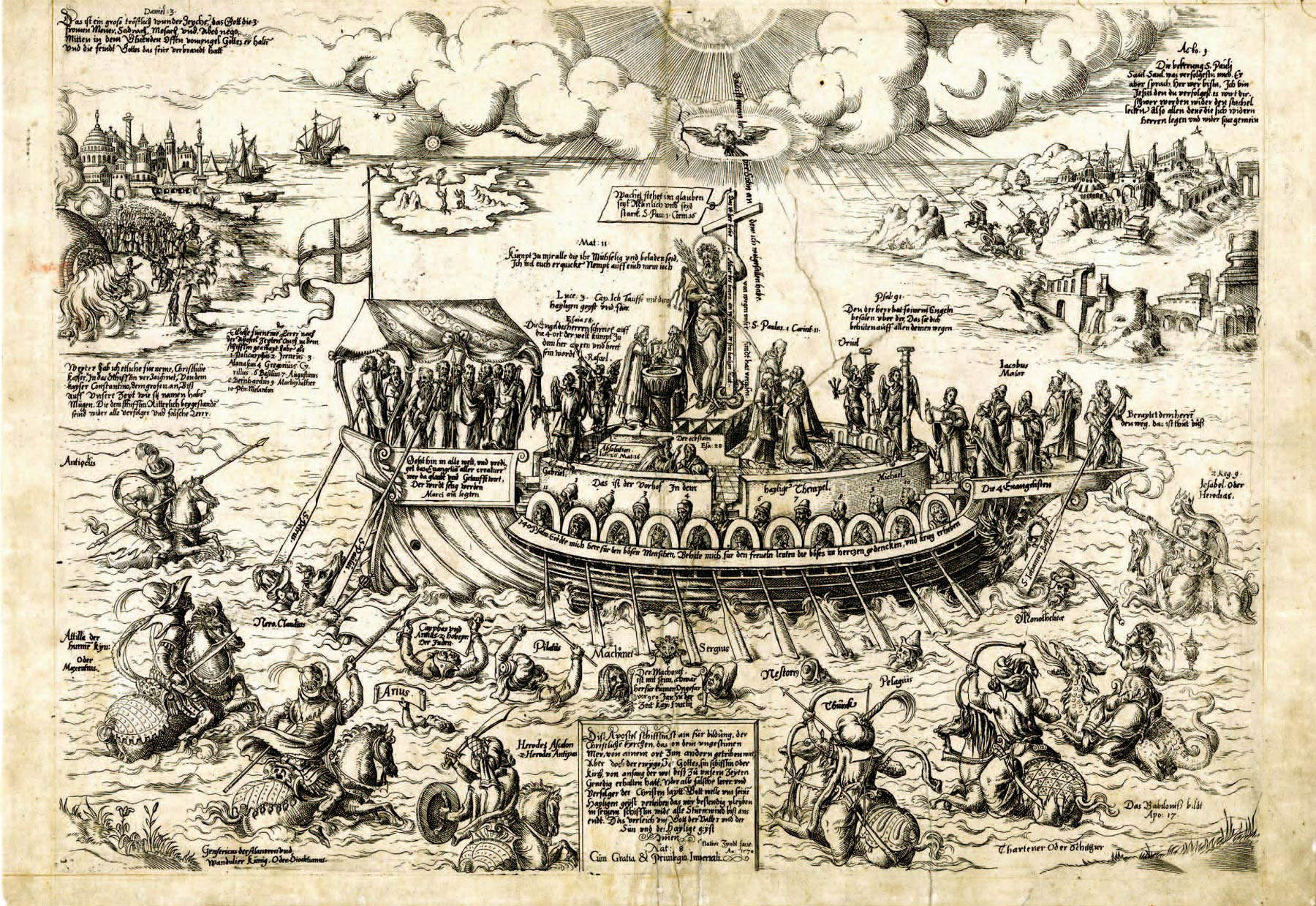

The reading of the image of the Triumphus Ecclesiae can begin with the figure of St. Peter, who in all three works (Rubone, Naurizio and Thomassin, although in Rubone it is barely legible due to bomb damage) stands at the helm, holds the keys of the Church and is accompanied by a banner where we can read the sentence uttered by Jesus in the Gospel of Matthew: “Tu es Petrus et super hanc petram aedificabo ecclesiam meam” (“You are Peter and on this stone I will build my Church”). Immediately in front of him, on the sterncastle, we see the figures of the apostles, who in Thomassin’s engraving are identified individually, and next to them, holding the shrouds, here are the six “fundatores religionum,” or founders of religious orders, namely St. Dominic (Dominicans), St. Bruno of Cologne (Carthusians), St. Albert (Carmelites), St. Augustine (Augustinians), St. Benedict (Benedictines) and St. Francis (Franciscans). On the prow bridge and castle we find a theory of saints hurling darts and spears at heretics, while at the oars are five Doctors of the Church (St. Thomas Aquinas, St. Jerome, St. Ambrose, St. Gregory the Great, again St. Augustine). Their oars symbolically represent the books of Catholic doctrine: the five books of Moses, the letters of St. Paul, the books of Solomon, the Gospels, and the twelve books of the prophets. Finally, on the crow’s nest we see Jesus sitting enthroned, holding a banner with the inscription “Rex Regum et Dominus Dominantium,” and on the sail here is the Virgin Mary, “dei genitrice fidissima duce.” Around them is a group of six angels with the symbols of Christ’s Passion (the cross, the scourging column, the crown of thorns, the nails, the spear, the sponge, the ladder). Themast, as we note from the inscription on it, represents faith in Christ, while the two anchors are the “good will” and the “desire for Heaven.”
We note that the Church ship is dragging three boats behind it, with different groups of captives: the Jews (“Ecce volente Deo duri sternuntur hebraei,” or “Behold, with God’s will the hard Jews are defeated”), the biblical kings led by the prophet Jeremiah (“ducuntur reges manibus post terga revinctis,” “the kings are led with their hands tied behind their backs”) and the emperors. Under the boats of the defeated kings, we witness a battle whose meaning is explained (“pro fide certant,” or “they fight for the faith”): the clash in question is that between the Persian emperor Cosroe II and the Byzantine Heraclius, defender of the faith and victor (the episode was also frescoed by Piero della Francesca in the cycle of the Legend of the True Cross in the basilica of San Francesco in Arezzo). In the image of Rubon, Naurizio, and Thomassin we can witness the final outcome of the clash, with Heraclius stabbing Cosroe to death, under the gaze of soldiers carrying Crusader banners.
Returning to the sea, we see two more boats, led by as many devils, but whose occupants are hit by arrows shot from the Church ship, and some of them are already floundering in the sea. These are the ships of schismatics and heretics: in the first we find Donatus of Carthage, Photius of Constantinople, and Sabellius, who were respectively at the head of Donatism (schism in the African Church in the 4th century), the Eastern Schism that prepared the groundwork for the Great Schism of 1054 and the subsequent birth of the Orthodox Church, and Sabellianism. Among the heretics, we see at sea Pelagius and Arius, founders of the heretical doctrines of Pelagianism (which denied the transmission of original sin to all mankind) and Arianism (which denied the divine nature of Christ), and also Martin Luther, in friar’s robes, accompanied by the inscription “niteris in cassu nave subvertere Petri” (“you will boast in vain that you destroyed Peter’s ship”). Below, on the ground, we see a group of crushed infidels, observe ruins of an ancient temple referred to as the “Templum Pantheon” (an allusion to the defeat of paganism) and, finally, a group of other infidels (recognizable by their turbans and scimitars) condemning some Christians to the stake, who receive from an angel the palm of martyrdom, for refusing to worship the statue of Nebuchadnezzar. The background is occupied by depictions of two cities, Damascus and Constantinople, the former with the episode of Saul’s conversion, and the latter with the entrance of a pontiff before whom the Turks prostrate themselves. Finally, above, in the clouds, we see the figures of the evangelists, who are arranged to the right and left of Christ. Among the few differences we notice between the images of Rubone, Naurizio and Thomassin the most conspicuous is certainly, in Thomassin’s engraving, the presence of St. Michael the Archangel on the prow of the ship, caught raising his sword and bearing the shield with the coat of arms of the dedicatee of the engraving, the French prelate Séraphin Olivier-Razali, who from 1602 to 1604 was Patriarch of Alexandria. Another difference, the presence in the upper part of Thomassin’s engraving of two prophecies, that of Blessed Cyril and that of Joachim of Fiore.
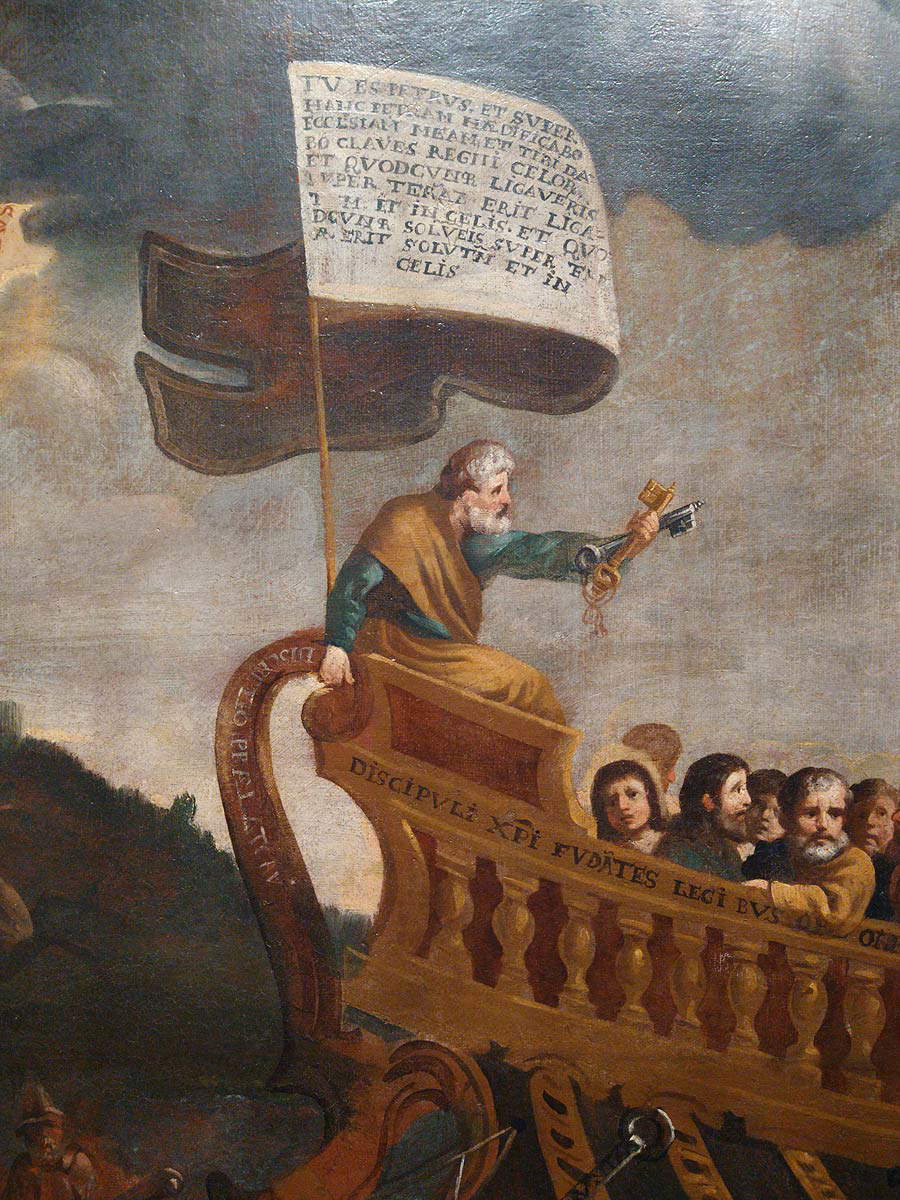

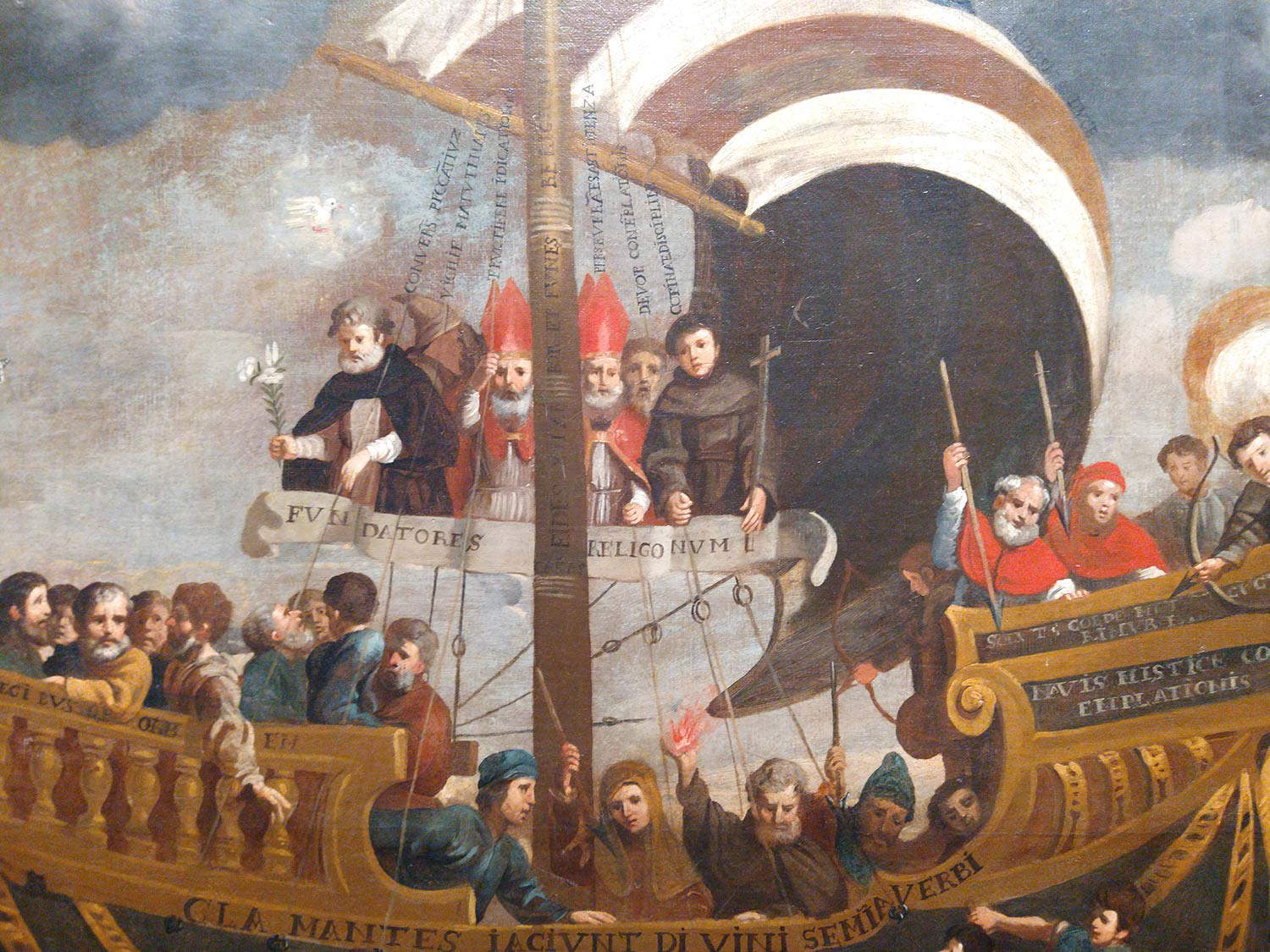
 Detail
Detail
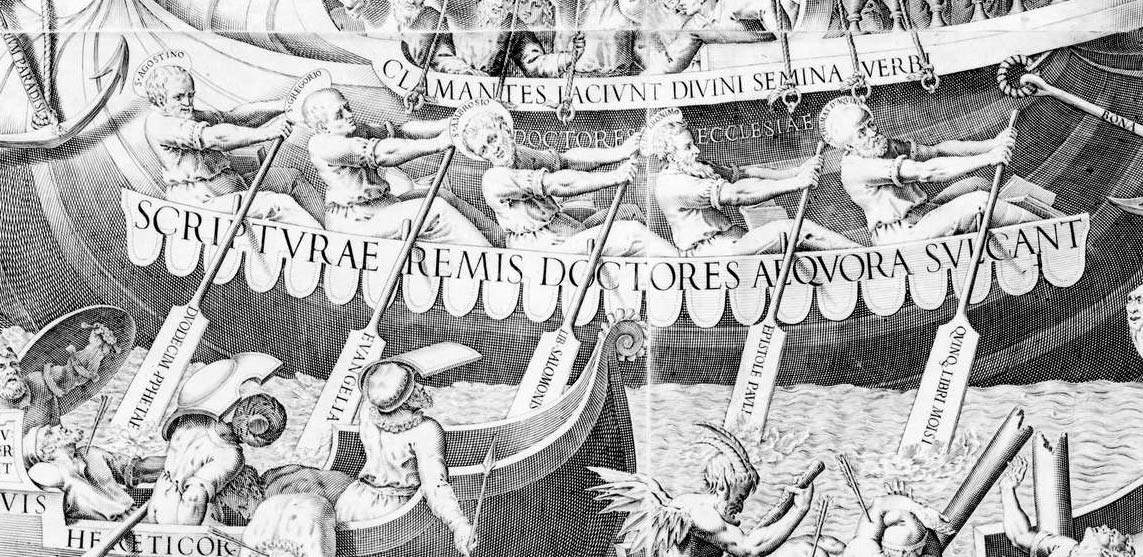
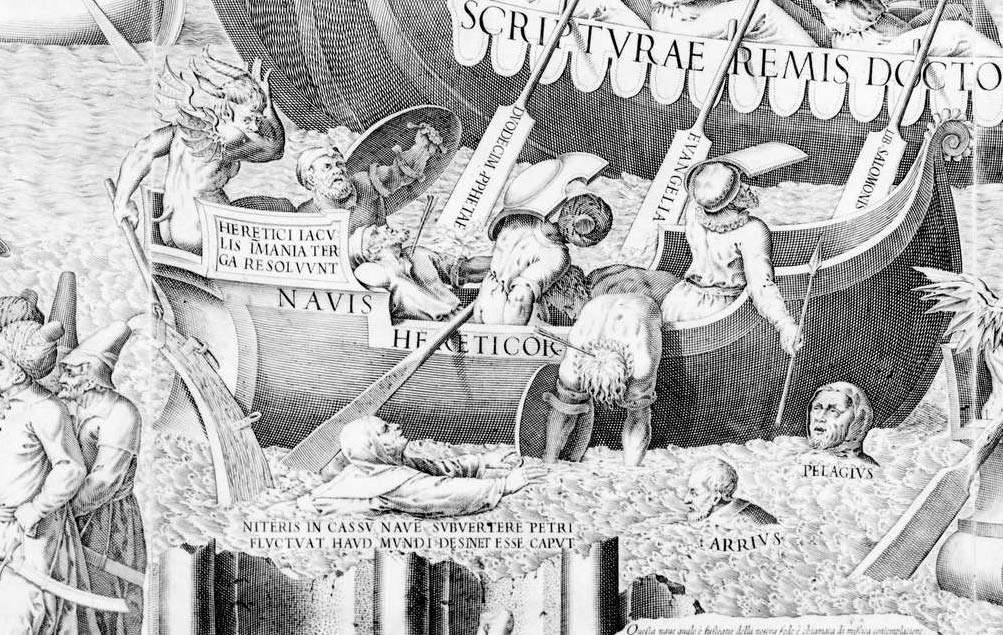
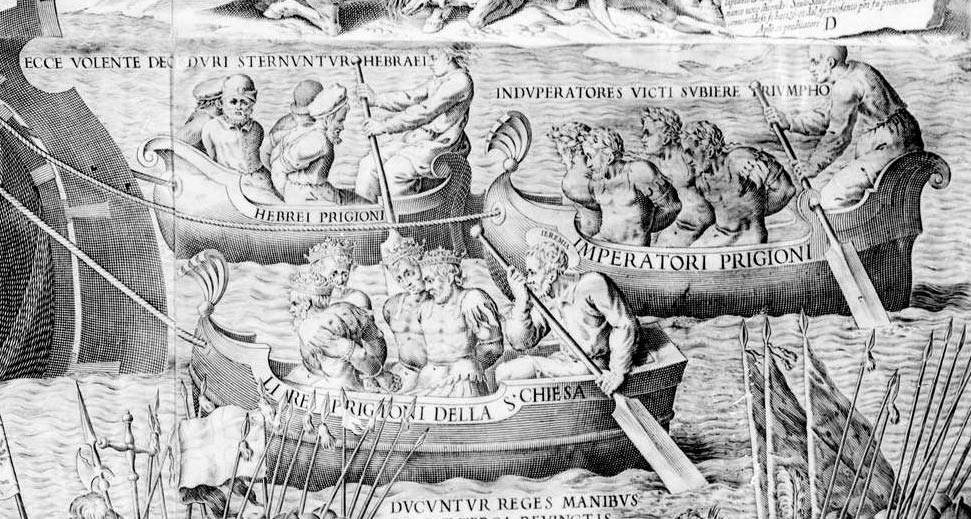
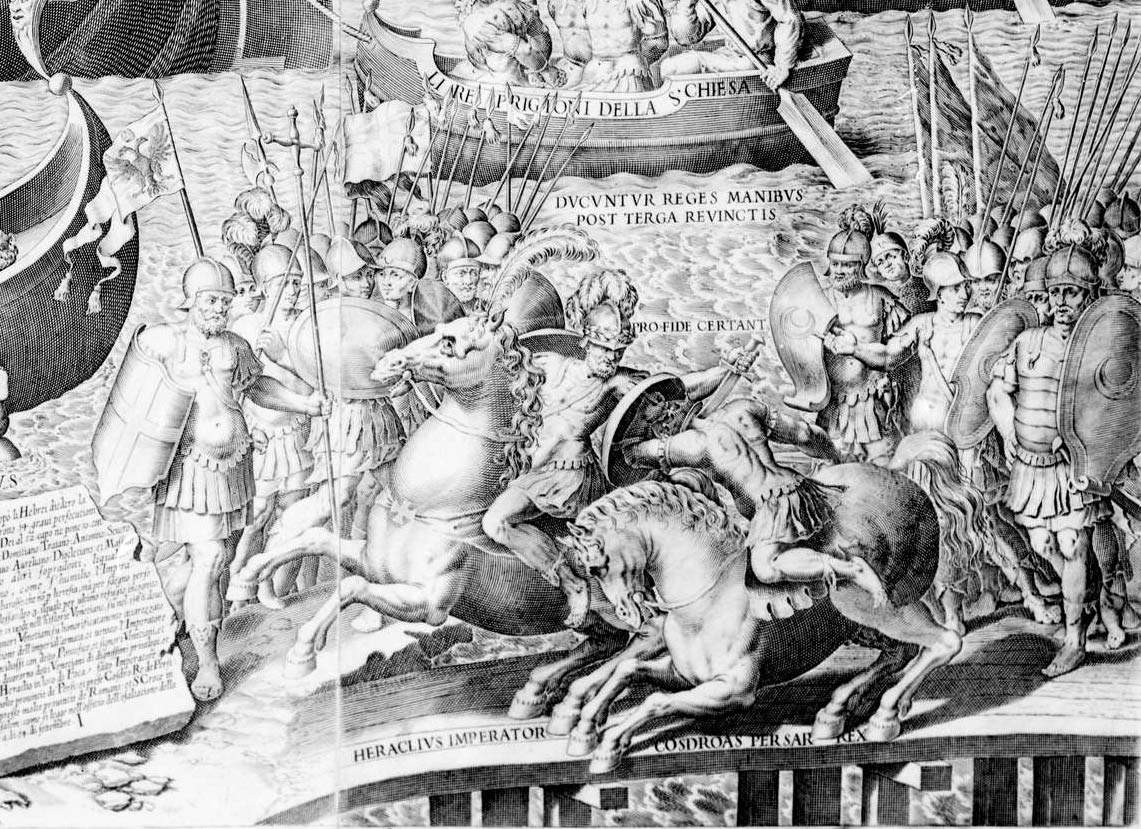
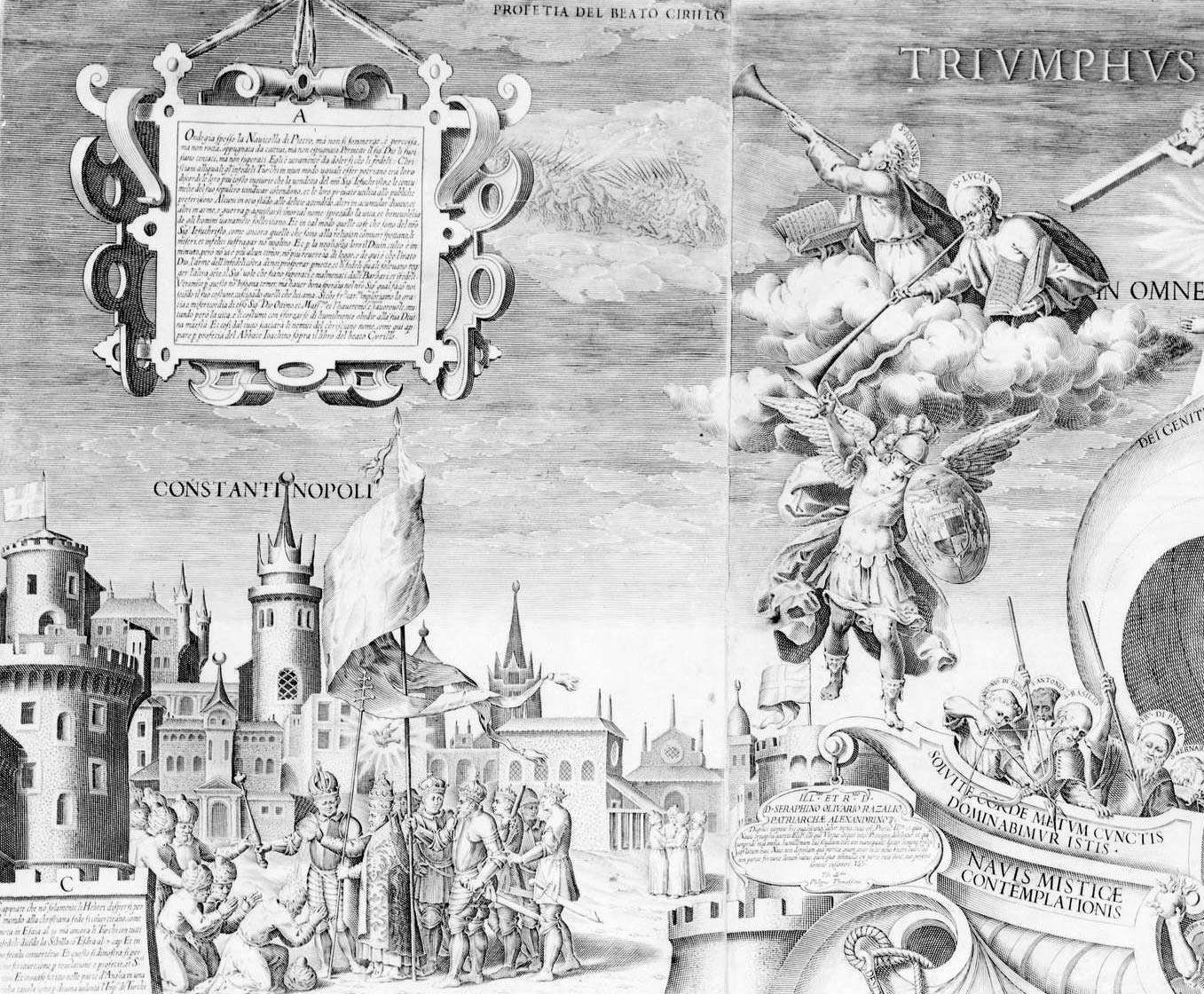
Interestingly, as scholar Federica Piccirillo wrote in the catalog of the exhibition Rome 1300-1875. The Art of the Holy Years in 1984, the method used by these artists (Piccirillo was referring to Thomassin’s engraving) to make the relative memorize concepts: “the visual-verbal nomenclature,” writes the art historian, “follows the canons of mnemonics: instead of letters from the alphabet we find doctrinal cartouches, visualized by images. The ship itself is formed by word-objects.” And again Piccirillo provided contextualization for the presence of the two cities of Constantinople and Damascus (“the topographical moments from which the ship-Ecclesia seems to set sail: heretical cities, with the insignia of the Muslim sultan, cities to be evangelized”), as well as, in Thomassin’s engraving, for the images of the two prophecies. The background responds to the logic of retracing the stages of Catholicism: from Paul’s conversion to the theme of martyrdom, to which corresponds “the exaltation of Christ’s passion, visualized by the objects-memories of martyrdom and propagated by the four evangelists” (in fact, it will be noted how the authors of the sacred texts sound trumpets, a symbol of the spread of Christ’s word in the world), the defeat of the first heresies that “leads in the allegorical victory over Luther and Calvin,” the presence of King Heraclius as a prefiguration of the “most Christian” and “most Catholic” kings. A vision that is charged with an “almost Vichian dynanism,” Piccirillo explains, catalyzed “in the metatemporal course of the ship [...], which travels its inexhaustible iter, alluding to the cultic policy of the Church, in the perspective of the missions,” and which forms the “cultural substratum of the allegorical triumph of the hierarchical church, doctrinal and institutionalized source.” The church, therefore, is identified with the triumph of faith and religion.
The images of the Triumphus Ecclesiae, with their obvious didactic and didactic character, are among the most iconic and immediate images of Church propaganda at the time of the Counter-Reformation: art, after all, was at the time considered by the Roman authorities to be the most effective means of spreading the Catholic faith and stemming any attempt to overturn Peter’s ship.
Reference Bibliography
Warning: the translation into English of the original Italian article was created using automatic tools. We undertake to review all articles, but we do not guarantee the total absence of inaccuracies in the translation due to the program. You can find the original by clicking on the ITA button. If you find any mistake,please contact us.